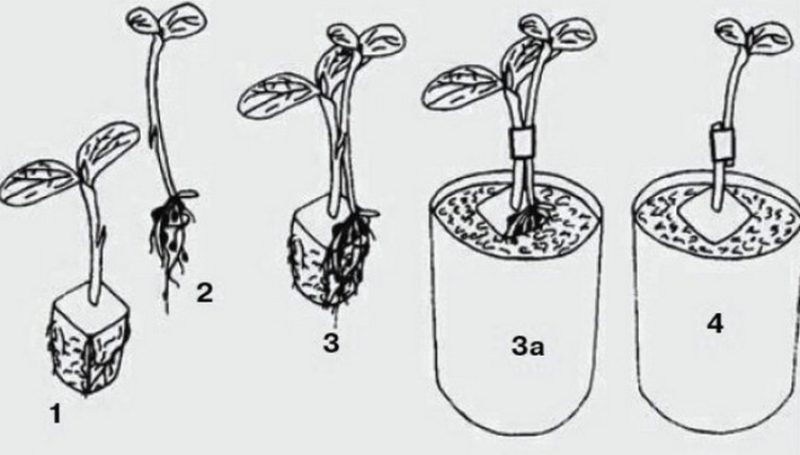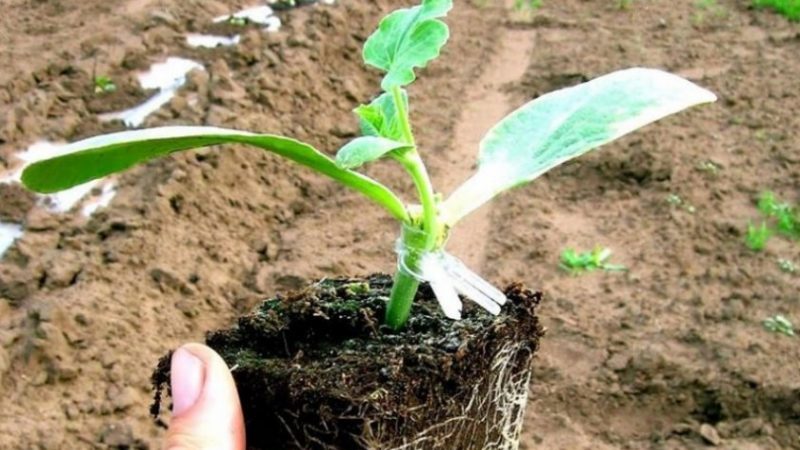Schemes and subtleties of grafting watermelon on a pumpkin
There are many varieties of cold-resistant watermelon, but it is not possible to achieve the same yield as in the southern regions. Therefore, the method of grafting a watermelon onto a pumpkin has become popular. This helps to get full ripening of the crop even in regions with insufficient heating of the land.
The content of the article
Why do you need a watermelon vaccination
The reason that led to the decision to combine these crops is the weak and too sensitive root system of the watermelon. She is uncomfortable at + 18 ° C. Pumpkin is more resilient and hardy in cool weather, even at + 7 ° C, its roots continue to receive nutrition from the soil.

The main advantages of grafting a watermelon on a pumpkin:
- resistance to negative environmental factors increases;
- the effect of pathogens that cause crop diseases (fusarium, anthracnose, root fungal rot) is reduced or completely absent;
- the growing season, the rate of development and the ripening time of the watermelon increase;
- the number of ovaries and yield increases;
- there is a possibility of early seeding in open ground;
- the need for moisture, heat and soil composition decreases;
- there is no crop rotation;
- drought resistance appears.
The main cons:
- not all pumpkin varieties are suitable;
- maximum care is required when vaccinating;
- fragility of young plants.
What is needed

Prepare for the procedure:
- for cutting: blade, scalpel, sharp knife;
- for dressing: strapping polyethylene tape, thread, bandage, aluminum foil, polyethylene strips;
- special grafting clips or clothespins with a smooth clamping surface;
- for tying: sticks or pegs to the size of the seedlings.
Tools must be sharp to avoid crushing the cells, and clean to prevent bacteria and dirt from entering. The cut contact should be tight, well pressed and securely fixed with a clip.
Reference. A large supply of plants should be grafted, since only a small part of the watermelon takes root.
Which pumpkin is better to graft on
Ornamental lagenaria is well suited for grafting watermelons. Long-term grafting on pumpkin has proven that it is Lagenaria (ornamental squash from the pumpkin family) that is in great demand and has the necessary properties for grafting watermelons.
The best varieties of watermelon are:
- Chill;
- Astrakhan;
- Chernouska;
- Kherson;
- Korean.
The main advantages of using Lagenaria:
- high compatibility of cultures, which helps the grafting take root;
- powerful root system;
- high survival rate even in cold regions;
- increased resistance to watermelon diseases.
It is also possible to plant a watermelon on fig-leaved squash and squash. These methods are used less often, since their effectiveness is less than that of vaccinations for lagenaria.
How will pumpkin affect watermelon
Influence of pumpkin rootstock on watermelon:
| Taste | Doesn't change. |
| Nutrition | More nutrients and moisture are supplied. |
| Survival | Resistance to unfavorable environments and endurance increases with a decrease in soil temperature. |
| Fruit | The palatability improves, they become more sugary, the number of fruits and their volume increase. |
When to get vaccinated
On the average, it takes about one and a half months for the necessary actions to graft plants, so the grafting time is calculated taking into account planting in the ground in each separate region.In the middle lane, planting of seeds begins from the end of March - mid-April, in the northern regions - from mid-April. Landing in the ground depends on the weather and the depth of soil warming. Most often this is mid or late May.
Read also:
How to make delicious and simple watermelon rind jam.
The most delicious recipes for salting whole watermelons in a barrel for the winter.
Features of growing watermelons in Siberia in the open field: step by step instructions.
How to properly prepare a plant
Sowing starts with watermelon seeds, as they grow more slowly. The volume of the container for seeds should be 200 ml. A few days later, the lagenaria is sown. You can inoculate with three leaves.
How to plant a watermelon on a pumpkin

There are many ways to vaccinate:
- tongue;
- to the center (split);
- rapprochement;
- end-to-end;
- in the injection;
- in a lateral section;
- into the tube.
Tongue
This is the most commonly used method. It gives good survival rate due to the large contact of the scion with the stock and the presence of roots in both pumpkin and watermelon.
The watermelon is planted three days earlier. The seeds are germinated in advance. You can sow them in one container or in different ones.
For grafting, a cut is made in the middle between the root and leaves on the rootstock (from top to bottom) and on the scion (from bottom to top). The cut should be 1-1.2 cm deep to the middle of the stem. Tongs are formed that connect and secure. The grafted plant must be tied to a peg.
After five days, the plants grow together. It is necessary to crush the lower part of the watermelon so that its root dies off and it switches to feeding from the roots of the stock.
Pumpkin leaves are removed during the growth of the watermelon so that three "native" leaves (two cotyledons and one real) remain.

By convergence
The only difference is in the connection method. A layer of skin is cut off from seedlings, after which they are connected and fixed for fusion. Other steps are repeated, as with tongue grafting.

Copulation
Copulation is similar to grafting in the butt. The main difference is the volumetric rootstock. The pumpkin must be planted at the same time as the watermelon, so that its stem is stronger and thicker.
Further, the growth point is removed, and one cotyledonous leaf remains. A cut is made on the rootstock from the removed leaf parallel to the stem 7-8 mm long. The graft is cut in the middle of the stem and connected to the plant. Then everything is fixed with a clip or tape.
Side cut grafting
The survival rate with this method is considered high, but not everyone knows about the possibility of using it for grafting a watermelon.
It is similar to grafting with a tongue, only the root system of a watermelon is removed immediately. The stem of the pumpkin is cut to the center with an oblique line, the stem of the watermelon is cut with an oblique cut through and through, leaving only a thin layer of skin on the other side. After the seedling is inserted into the incision on the stem of the pumpkin and fixed.
Vaccination in the center (injection)
Fast, easy and efficient way.
The pumpkin must be sown earlier in order to obtain a thick and strong stem by the time of grafting. The growth point is removed before inoculation. The center of the stem is pierced with a toothpick or a sharp stick to a depth of 5 mm. The stick or toothpick remains in place until the moment of vaccination. A watermelon 3-4 days old is cut obliquely and inserted into the puncture site. No fixation is required, as the scion sticks on its own.
There are general guidelines for grafting a watermelon:
- sterility: tools and hands should be cleaned with alcohol;
- grafting is performed in the evening or cloudy time;
- the container for the pumpkin should be of a larger volume;
- the day before vaccination, the stock is watered with a sufficient amount of water;
- for plants to grow together, it is necessary to maintain high humidity (70%) in the place of their placement;
- protect from direct sunlight;
- t + 25 ... + 28 ° C.
Read also:
Why is watermelon juice useful and how to prepare it properly at home.
Grafted plant care

When caring for seedlings during accretion, be sure to monitor the moisture content of the soil in the container with the grafted plant.
At the same time, there is often no need to water, it is important not to overdo it in order to prevent decay of plants. The seedlings grow together on the 5-7th day.
The watermelon begins to grow stronger and grow upward, new leaves appear. After it is necessary to squeeze the second and third leaves or cut off the scion sprout near the ground. If stable growth continues, the clip is removed.
Important! With poor removal of the growth point of the pumpkin and the active development of its leaves, they must be pinched and removed.
Planting is carried out in well-fed soil. Water once a week.

Conclusion
Grafting a watermelon to a pumpkin is not a very simple process, but an exciting one. More and more gardeners are using it to grow watermelons in regions with a harsh climate. With a little effort, you can get a large harvest of sweet fruits.